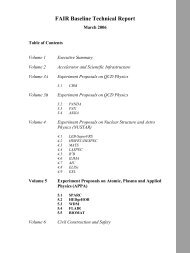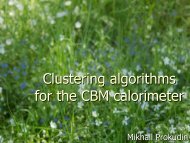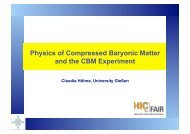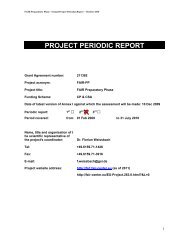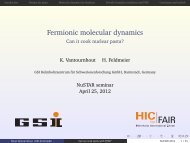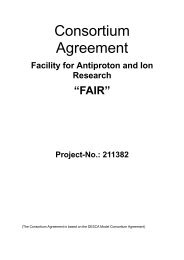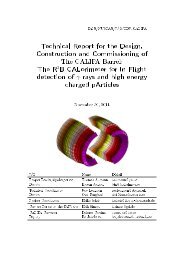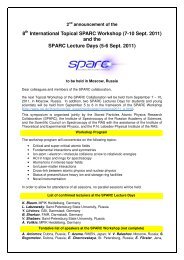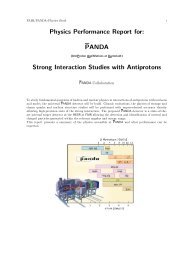NeuLAND - FAIR
NeuLAND - FAIR
NeuLAND - FAIR
You also want an ePaper? Increase the reach of your titles
YUMPU automatically turns print PDFs into web optimized ePapers that Google loves.
Since, as discussed above, several hits in the detector occur per neutron, it is essential<br />
to find not only the correct number of neutrons but also to reconstruct their momentum<br />
from the first interaction point.<br />
In the following we describe the methods developed for the <strong>NeuLAND</strong> neutron reconstruction,<br />
as of today. It turns out that a generalized tracking mechanism alone does<br />
not lead to satisfactory results with respect to the multi-neutron identification. Instead,<br />
we use a method which combines tracking with calorimetric information in order to<br />
resolve multi-neutron events. We first introduce the definition of a valid cluster in Neu-<br />
LAND, then detail the calorimetric resolving power and finally, by a combination of<br />
both, determine the number of neutrons and their momentum.<br />
Clusters<br />
Within one event a hit in <strong>NeuLAND</strong> is defined as a coincident observation of a signal,<br />
above threshold, at both ends of a <strong>NeuLAND</strong> submodule. The hits are sorted time-wise,<br />
and then, in a first step, neighbouring hits are identified, starting from the first hit in<br />
time. Hits belonging to a cluster are thus defined by certain distance in space (≤ 7.5 cm<br />
in x, y and z each) and a certain time difference (≤ 1 ns) to at least one other member<br />
of the cluster. After all hits have been assigned to clusters, for each cluster only the first<br />
and last hit in time are stored. 3 Again, the clusters are sorted according to their time of<br />
the first hit. The first cluster is treated as occurring from a first interaction of an incident<br />
neutron. For all following clusters a procedure with kinematical conditions is applied<br />
in order to check whether these clusters could stem from elastically scattered neutrons<br />
from a prior incident point with an earlier cluster. That takes into account the scattering<br />
angle of the particle of the earlier cluster (most likely a proton), which we define from<br />
the first and last hits of the cluster. If one of the later clusters fulfills the criteria of<br />
an elastic scattering process of the incident neutron, this cluster is eliminated from the<br />
further analysis. This procedure is iterated for all clusters until no more correlated<br />
secondary clusters can be found.<br />
The number of remaining clusters still is substantially higher than the number of incident<br />
neutrons and depends on the energy of impinging neutrons. Exemplarily, for 200 MeV<br />
neutrons, a mean value of about 2.7 clusters is observed for one-neutron events, at<br />
600 MeV the value increases to about 6.3 and for 1000 MeV we observe on average<br />
10.5 clusters per neutron. In figure 4.13 the number of clusters is displayed for one- to<br />
six-neutron events at 600 MeV. The overlap of the number of clusters for the different<br />
neutron channels is large. Therefore, in the following we detail the use of the calorimetric<br />
properties of <strong>NeuLAND</strong> for the assignment of proper neutron multiplicities.<br />
3 As special case hits without any neighbour are defined as clusters by themselves.<br />
53





